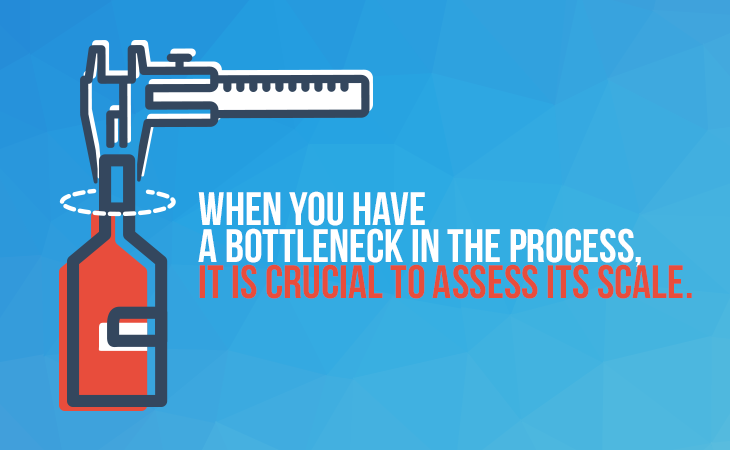Are you troubled by bottlenecks in the process of developing your new, awesome product? If not, you are one of the lucky few and will find the next paragraphs more interesting than useful, but if you can relate to that tight part of the process that slows down the whole flow we have just the right thing to assist you.
The Bottleneck Effect. What Is This?
Before we start looking for solutions to prevent or alleviate bottlenecks, let's make sure that we get specific about what bottlenecks exactly are and what contributes to their occurrence. A bottleneck is any part of a process with limited capacity that lowers the overall capacity of the production line by slowing it down.
Presented otherwise, it is a point in the development flow at which the arriving work cannot be handled as fast as it arrives, leading to a longer cycle time of the whole process of development. Bottlenecks usually cause supply overstock, stalls in production, longer queues, additional pressure from customers, frustrated employees and may easily contribute to occupational burnout throughout the company.
The term "bottleneck", used in this context, is part of the Theory of Constraints, introduced in 1984 by the Israeli business guru Eliyahu M. Goldratt. According to him, every system is limited in exceeding more than its goals by a number of constraints. His philosophy aims to identify and remove these constraints or bottlenecks by restructuring aspects of the organization.
Quick Bottleneck Analysis
Bottlenecks are categorized by the period of time in which they occur, short and long-term, respectively.
- Short-term bottlenecks are likely to happen all the time and can be caused by a wide range of mishaps like a technical glitch, temporary absence of personnel, training of new team members, etc. For example, the holiday season is right around the corner, and key employees will go on their vacations, leaving their work to somebody else or, in some cases, unattended. This can easily create bottlenecks if the organization's workflow is not optimal. Let's say one of your key customer relations officers leaves for two weeks and delegates her work among three other people from the department. She hands over time-sensitive tasks and leaves. The remaining members of the department continue to do their jobs while covering for their missing colleague and work starts to pile up, creating a bottleneck. If they fail to collaborate effectively, there will be a delay in both their usual work and the temporary addition to their load. The result - a delay in sales, delay in getting revenue, missed deals, etc.
- Long-term bottlenecks are a significant hurdle for any company because, unlike their less menacing, short-term version, these cannot be dealt with as easily. They are likely to happen when a company is taking more work than it can handle. For instance, if you are a software company and intend to introduce new features without hiring new engineers, while the ones you have are already working at full capacity, your workflow will either slow down or your employees will have to work beyond their limits. The slower workflow will leave you with a bottleneck while overworking your staff will enhance the risk of their burnout.
How to Eliminate Bottlenecks?
The bottleneck in business. Easy to spot but difficult to eliminate.
In order to remove them, first, you need to identify them. The easiest way to do it is by visualization of the whole workflow of your company and the use of analytic tools to measure the cycle time of every process that occurs in the workflow.
Lack of capacity and efficiency in the company contributes to the formation of bottlenecks. To avoid it, you need to carefully calculate the overall capacity (technical, human, time, etc.) that your company currently possesses and whether your team can handle any additional workload without slowing down the overall development process. Analyzing the efficiency of the ongoing processes is another key action that should be taken regularly as well in order to eliminate the unnecessary waste created by unnecessary actions.
Burnout levels need to be monitored closely or you risk losing some of the current capacity and instead of making your product better and increasing your revenue, the company may end up with a new bottleneck and underperforming staff. Burnout cannot be measured precisely, but with constant attention to the team members, it can be made evident by the behavior changes that occur among those affected.
If the general workflow is not organized and visualized precisely, it won't be able to reach its full capacity or exceed it and will create a long-term problem for the company. If you are using a visualization tool, such as a Kanban board, in your daily process management, bottlenecks can be seen clearly and it is going to be very easy to point out what causes them. If visualization is not enough, a thorough analysis of the stability of your workflow will show you the problem, but it is going to be slower and in the meantime, the existing bottlenecks may tighten. Then comes the hard and in many cases, expensive part - dealing with them.
In order to eliminate bottlenecks, you must take the necessary measures to prevent them. Setting limits on the number of work items each person is allowed to take on at a given time is a great idea for this purpose. They ensure that every team member keeps a steady pace and does not overwork themselves.
Another great thing about work-in-progress (WIP) limits is that they show you if somebody is slacking and the bottleneck is caused by individual negligence rather than collective. When it is clear what workload is lying on the shoulders of which colleagues, the chance of bottlenecks caused by their absence can be reduced significantly. Before they leave, for, let's say, a maternity leave, their work can be delegated accordingly to as many people as needed in order to avoid slowing them down and yet not lose track of the process, due to the segmentation.
When you have a bottleneck in the process, it is crucial to assess its scale.
If it is too late to prevent bottlenecks and you already have one on your hands, the first thing that needs to be done is to assess the situation and measure its scale - minor or severe - and pinpoint what caused it. In most cases, minor bottlenecks may look like they do not need immediate attention and are more annoying than dangerous, but if they are not attended to, they may become severe.
An example of this is when you have a non-scalable architecture of your software. In the beginning, it seems like an annoyance to you, because it does not cause serious damage, but if you do not fix the problem, with the further development of the product, the bottleneck becomes severe, as it gets harder to make changes in the architecture.
The best way to eliminate bottlenecks is to increase the capacity of the process creating it by restructuring the workflow or investing in people and equipment. The cheaper and more effective way to deal with it is to restructure your internal processes in order to optimize them and move additional resources from a phase of the process with an excessive capacity to one where there is a bottleneck.
When it comes to restructuring, it is extremely important to remove non-value activities, which generate a zero or negative return on investment. By doing this, you get rid of the waste in the process and reduce the redundant tasks from the workflow. In most cases, this is the best way to alleviate a bottleneck because additional capacity is made available and the cycle time becomes shorter.
Protecting the bottleneck is another great way to deal with it. Assuring that the bottleneck works only on quality parts is a wise thing to do. If you need quality checks in the development process, make sure that you place them before the bottleneck.
For example, make sure your programmers send only well-written code to the QA-s when developing the new features of your product. Quality assurance is prone to bottlenecks in most cases because it is almost always understaffed. By doing this, you will make sure that the bottleneck won't waste time on bad parts and will increase the throughput of the process.
Investing in more resources, such as new machines, more personnel and etc. are the simplistic but more expensive solution that often prove not to be the wisest. If you are sure that your processes are as optimized as possible and there is no capacity left to be relocated, investing may prove to be the only option that you have.
There are a few aspects on which you should focus depending on the bottleneck. For starters, increasing the number of staff can be beneficial for multiple reasons. In most cases, this will increase efficiency because it will give you the opportunity to rotate people who share similar responsibilities and reassign them from a place with excess capacity to one where there is a bottleneck.
When it comes to product development, investing in new people is not always the best choice, as every person in the process is responsible for different things, especially if you are not a large corporation. For example, if you see that a given person is the reason for a bottleneck, you should analyze his or her duties.
If you see that she is taking on too much work, you can either give a portion of it to somebody with similar responsibilities but less on her plate or invest in a training course for the overloaded person. It is going to be cheaper than hiring a new person and training her from scratch because the current team member will apply the new skills immediately to their full potential, while the new face will have to walk a long path towards working efficiency.
Investing in new hardware is something that needs to be done once in a while in order to keep your technical capacity as high as possible, because even if you have the best experts in the world in your company, if you give them outdated machines to work on they won't be able to reach their full potential.
This applies especially when there is a bottleneck somewhere in the process. A simple example of that is when you hire a great young web developer and put her on a decade-old computer to write her code. Will she get the job done? Probably. Is she going to do it without forming a bottleneck? Unlikely.
We hope that by reaching this part of the article you have learned something new, which will be useful in your work. Make sure that you and your company are ready for the summer and ensure your organization against unnecessary and easily preventable problems during the hottest time of the year. If you are going to have a bottleneck in your hands, make sure that it is going to be of your favorite beverage.

Alex Novkov
Content Lead
Energetic and practical, passionate about social media, creative writing, heavy weights, and outdoor activities.




